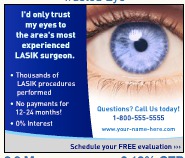AdReady's design library powers response rates for display ads
AdReady’s self-serve design library includes historical click-through percentages for each ad so customers can select high-performing ads that have been tested in other markets.
The advantage in cost savings is obvious. But the quality of the banner ads in the service is arguably as good or better than online ads that inhouse creative services typically produce.
Walking through the ads for Lasik, for example, you find good-looking clip-art faces with short, get to the point headlines. Brands don't come through as well, but it has always been difficult to create branding on internet display ads, which are better suited to offers anyway.
Ads are customizeable and click-through rates also help designers and reps develop an "eye" for good design. An added benefit is that showing click-through rates is an easy way to get SMB advertisers to make good choices.
”If I’m a small business, let’s say a lasik surgeon, my designer is usually going to build an ad that looks like my web site. If it doesn’t work I’m going to blame the media. And this has a horrible impact on performance. It can make display advertising unpopular,” says Aaron Fin, CEO of AdReady.
Hoping to go deeper into its own market, the New York Times has used AdReady for local ads.
“If a book publisher wanted to spend $2000, the New York Times used to turn it down,” Finn says.
MSNBC, ESPN and Hearst Corporation are also using the software to gain market share, and Yahoo is using the system to convert its search customers to display ads using its own sales force.
”There are currently 1 million and a half search advertisers and only 44,000 display advertisers. It is our belief that at least a million of these should be doing display advertising,” says Finn.
Some local media partners use the software as a pure DIY model, but most use a combination of support levels. New York Times, for example, has in-house customer service for customers with budgets less than $10,000, but clients spending more than $10,000 get a personal sales representative.
ESPN Your Way lets customers use the DIY system for campaigns under $3000; over that amount gains access to a group account coordinator, and customers who spend $25,000 or more get a personal representative. Some media partners use their own frontline customer service support, while others use AdReady’s help desk.
The San Francisco Chronicle and the Houston Chronicle also subscribe, and Univision has sales teams selling digital banner ads packaged with radio advertising in Fresno and Miami.
Finn says small publishers with Unique Visitors (UV's) in the 100,000 to 500,000 a month range can are making $25,000 to $50,000 per month in display advertising sales using his software “depending on their commitment to the digital transition.”
“They have to be committed to moving their sales force on to digital. Our technology isn’t going to bring the advertisers. 100 percent of the leads are marketing and sales force driven. Yahoo (sales on the platform) is 80% is sales team driven.”
Finn, who got his start as marketing director for classmates.com said that is where he began to understand the power of how details in display advertising design disproportionately affect conversions.
He sees more ROI tracking as the wave of the future: ”We (currently) generate a tracking pixel, that links the ad to the action, based on the session. Car dealerships always want leads, so now we are starting to see how many people use (the dealers) directions page to show out how much traffic they are getting from us on weekends. Now we can optimize that ad to get more showroom traffic.”

The author, Alisa Cromer is publisher of a variety of online media, including LocalMediaInsider and MediaExecsTech, developed while on a fellowship with the Reynolds Journalism Institute and which has evolved into a leading marketing company for media technology start-ups. In 2017 she founded Worldstir.com, an online magazine, to showcases perspectives from around the world on new topic each month, translated from and to the top five languages in the world.













